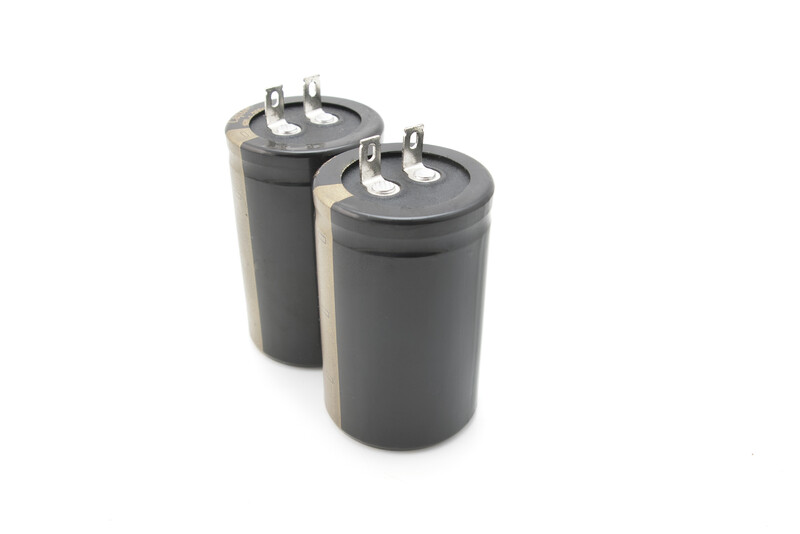Is your pool pump tripping the circuit breaker (GFCI) and you don’t know why? In this article, we’ll give you the full breakdown of how to troubleshoot and fix a faulty pool pump that keeps tripping its circuit breaker.
Pool pumps trip circuit breakers and GFCIs or RCDs when the current pump draws exceeds that of the breaker, or there is an earth fault. The most common reasons for a pool pump circuit breaker to trip are an overloaded motor, bad motor windings or bearings, loose wire, faulty capacity or moisture in the motor.
Whether your pool pump breaker trips immediately, after a few seconds, a few minutes, pr an hour, this guide has you covered. This guide also applies for all brands including Pentair pool pumps tripping breakers and Intex pumps tripping breakers.
Article Contents
Top 10 Causes Your Pool Pump Keeps Tripping the Breaker or GFCI
A quick disclaimer: pool pumps and working with power is potentially deadly. Anything suggested here should be done by a qualified electrician.
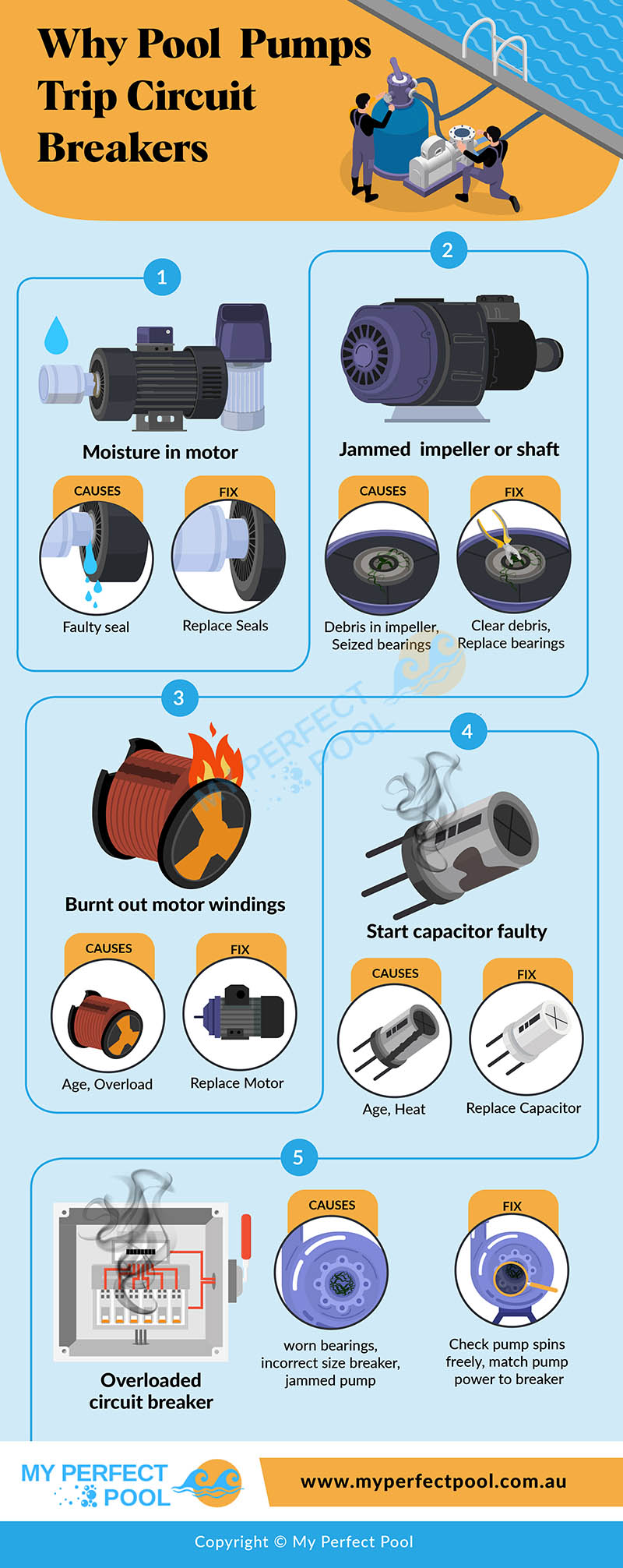
1. Water or Moisture in the Motor
Yes, although a pool pump’s job is essentially moving water, the electrics and the motor cannot get wet. If you notice that the pool pump keep tripping breaker after rain, it’s likely that your problem is caused by water getting into the pump or in the terminals or wiring. If moisture gets inside the motor’s coil, it can short and trip the circuit breaker.
To fix this, you’ll need to let the pump dry out completely. You can speed up the process by opening the pump housing and using a heat gun or hair dryer. Make sure you switch the pump off at the breaker first.
To prevent the problem recurring, try covering your pool pump to better protect it from the elements, and ensure that there’s no water pooling around it when it rains.
2. Dust and Debris Getting Inside the Motor
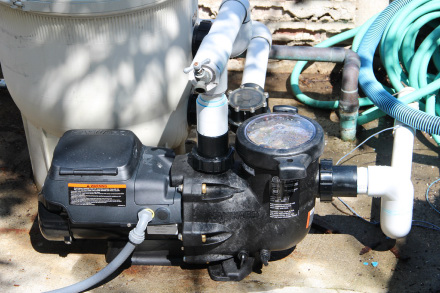
Anything that makes your pool pump motor work harder can cause it to overheat, and if it is getting too hot, you’ll have a pump tripping problem. Too much debris or dust building up inside the motor will do exactly that.
When the pump’s housing clogs up, the motor has to work harder. When the pump motor is working harder it draws more current.
Ultimately, an overworked pump can exceed the current limit on the breaker which and when this happens, it will trip.
To fix this issue, firstly switch off the pump at the breaker. Now grab a brush and vacuum and make sure all the air vents on the motor housing are clear. Clean and dirt, dust, debris from around the pump so it doesn’t get into the motor.
If the dust is particularly bad, you can open up the motor housing and vacuum it using a brush to dislodge any dust.
3. Motor Windings Are Bad
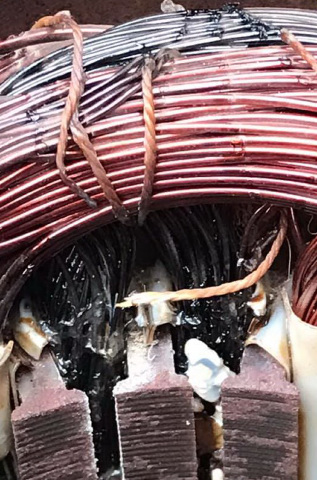
Motor windings do go bad and when they do they cause a short circuit and this trips power breakers. I’ve had this problem many times when I worked as a technician.
After a certain age, the insulation around the pump’s motor windings starts to break down and wear off. And when that happens, the windings cause low resistance which means the motor draws too much current.
Too much current draw means the power breaker trips.
To check this, you’ll need a multimeter or Ohm meter. Turn the pump circuit breaker off, disconnect the wiring to the motor. Now measure across the terminals of the motor. You may need to open the motor housing too so you can measure directly on the terminals.
Very low resistance or no resistance can mean the windings are faulty. Sometimes this is hard to diagnose without swapping the motor.
- Measure voltages, capacitance & resistance
- Diagnose swimming pool or hot tub equipment electrical issues
- IEC Rated CAT III 1000V
4. Underrated Power Circuit or Breaker to the Pump
This is most likely if the circuit breaker tripping started when you got a new pump installed. It’s possible that the wiring and circuit breaker or GFCI are rated too low to cope with the power demands of the new filter pump.
You can check the circuit breaker amperage (current) rating yourself. Go to the power board and read the writing on the breaker to the pump. You’re looking for the current rating and it will be something like 20A or 20 amps. Most pool pumps will need a 20-30 amp circuit breaker.
Related Reading: How to Fix Hot Tub Tripping GFCI Circuit Breaker (Repeatedly)
5. Old Wiring Between the Breaker and the Pump
As the wires age, the insulation can break down. And when this happens, the power can leak between the different wires. And the problem is worse if there is moisture – water conducts electricity.
You’ll need an electrician to sort this one out for you.
6. The Wiring Terminals Aren’t Tight
Wires connecting to the pump, the breaker, pool pump timer and any electrical disconnect (switch) must be tight.
- Essential for electrical work safety
- Non-conductive coating to minimize chance of electrical shocks
- Rated to 1,000 volts AC
Never tighten terminals without confirming there is no power to them – you could easily kill yourself if you don’t know what you’re doing. Best let an electrician check this for you. Use a high quality insulated electrician’s screwdriver if you do tighten the terminals.
7. Worn Pump Bearings
Faulty pool pump bearings can cause the circuit breaker to trip as the pump has to work harder when the bearings aren’t turning freely.
When this happens, the pump gets hotter and draws more power to try to spin. If the current the pump is drawing exceeds the rating of the circuit breaker, the breaker will trip.
To check this, turn the impeller by hand. The shaft should spin freely. Make sure you turn the pump off at the breaker before you do this.
8. Jammed or Stuck Impeller
Impellers can sometimes get jammed up or stuck completely. A jammed impeller means the motor draws more current overloading the circuit which then causes the circuit breaker to trip.
To stop the circuit breaker tripping, open up the pump housing and inspect the impeller. It should spin easily. Check for debris such as leaves or other things that shouldn’t be there.
If there is a blockage, clear it out, reassemble the pump, turn the breaker back on and restart the pump.
9. Blockage in the Suction Side of the Pump
If there is a blockage on the suction side of the pump, the pump will need to work harder, possibly overloading the circuit. The blockage could be in the skimmer box or in the pipes between the skimmer box and the suction side inlet of the pump.
Try cleaning out the baskets and lines.
10. Motor Starting Capacitor is Bad
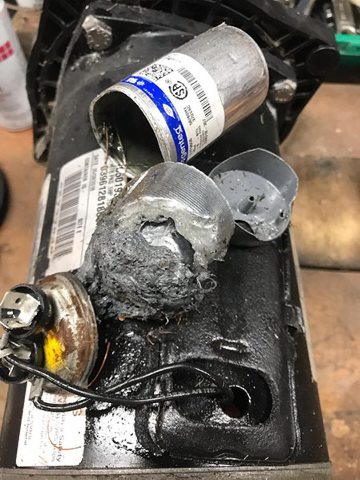
Most motors have a large capacitor in them to get the motor started. It’s common for these to go bad. And when the motor starter capacitor is bad, sometimes it can cause the power to trip.
- Fixes pool/spa motors that won't start
- Fixes intermittent motor starting
- Range fits most pump motors
One sign that this could be an issue is if when you switch on the pump it hums and doesn’t turn – then trips the power and stops. Before you swap this part, make sure there are no blockages in the impeller and that the main shaft of the pump turns easily.
The location of the capacitor is different on different pool pumps. You should check your pool pump’s guide to locate the capacitor. It’s usually on the electrical end of the motor, under a cover.
Make sure you discharge the capacitor before working on it as it can hold charge and give you a deadly shock. Again, this is best left to a qualified electrician.
Sometimes, you can tell if a capacitor has gone bad by just looking at it. If the top part of the capacitor is swollen or has burn marks it may be faulty.
Other times you can measure it. To do this, disconnect it. Change your multimeter setting to ohms and connect the probes of your digital multimeter to the terminals of the capacitor. If the reading of the multimeter is 0 Ohms, there could be an issue. Replace the capacitor and then try the motor again.
What Else Could be Causing The Circuit Breaker to Trip?
In most cases, if your pool pump is constantly tripping the circuit breaker, it will be because of a bad motor or blockage.
These problems are now fairly complex, and we advise you to get an electrician around to have a look at your pool pump. They should be able to tell you what’s wrong with the pump, fix wiring issues or point you in the right direction.
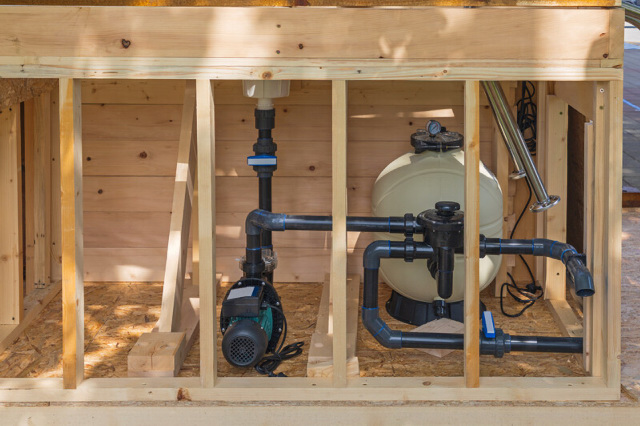
Related Reading: What Gauge or Thickness Wire Does a Pool Pump Need?
How to Troubleshoot Pool Pump that Trips the Breaker
We don’t recommend you try to troubleshoot a pool pump on your own. The best option is to call a qualified electrician. Pool pumps are electrical machines and can cause some serious harm if you don’t know what you’re doing. Any loose or exposed wires can electrocute you. So, don’t try to do it on your own.
With that out the way, we covered the reasons why your pump might trip the power above. Here’s the steps to begin troubleshooting your pool pump:
1. Make sure the pump is primed:
Whenever a pool pump is closed or not filled with water, it gets filled with air. Before beginning to troubleshoot, you’ll have to get rid of the air trapped inside by blowing it out with water.
You can do this by switching off the pump, opening the lid and filling it up with water. Now switch it back on.
2. Disconnect the motor from the pump:
You’ll need to identify if the problem is with the motor or the pump itself. Disconnect the bonding wire that runs from the circuit board to the motor. It’s just a matter of taking off the screw that connects the bonding wire to the motor.
You need to disconnect it first because it’s a very thin wire and can break easily when isolating the motor from the pump. Again, make sure the main power source is off.
Now, take the cover off the back of the motor to expose the terminals. After checking again there is no power at the terminals with a voltmeter, you can disconnect the wires. Put a terminal connector on each end and cover it with electrical tape to make it safe whilst it’s disconnected.
Now you can turn the breaker and pump timer back on. If the breaker still trips, this will confirm that the problem is with the wiring to the pump motor, not the pump motor.
3. Measure the resistance of the pump motor:
If the circuit breaker doesn’t trip after disconnecting the pump from the motor, it’s likely the pump. The next step is to measure the resistance of the motor.
- Measure voltages, capacitance & resistance
- Diagnose swimming pool or hot tub equipment electrical issues
- IEC Rated CAT III 1000V
To do this, get a digital multimeter. Take the top electrical covering of the motor using a screwdriver. Set the multimeter to Ohms or Resistance, and place its probes on the terminals (L1 and L2).
These terminals are usually labelled on your motor, so they should be easy to find. Again, USE EXTREME CAUTION. CONSULT AN ELECTRICIAN IF YOU’RE NOT EXPERIENCED. You should wear rubber gloves because these wires have 240v on them.
If the reading of the circuit’s resistance is below 1 Ohm it could be too low which means the circuit breaker will trip.
A high reading, over 1 Kilo Ohm could indicate the windings of the motor have gone open circuit – this wouldn’t usually cause a breaker to trip though. The motor just wouldn’t start.
4. Other Troubleshooting Steps:
Once you’ve completed the discussed troubleshooting steps, you can confirm if there’s something electrically wrong with your pool pump or its motor. If these steps didn’t identify the problem, you should move onto some non-technical troubleshooting. Here’s what else you can check:
- Check for any blockages that can overload the pump. Check inside the pipes and the pump box basket. Make sure it’s free from any sort of blockages.
- Check the pipes and the pump box for any kind of wear and tear that could be causing the air to leak.
- Check the bearings and shafts to make sure they’re freely spinning.
Related Reading: Do Pool Pumps Require GFCI Breaker Protection? Rules, codes and laws for Above Ground Pools.
FAQs
Pool GFCI Repair: Is it Possible?
Pool GFCI (Ground Fault Circuit Interrupter) repair is possible. GFCI devices are crucial for pool safety, as they help prevent electrocution by cutting off power if an electrical current leakage is detected.
If a GFCI for a pool is not functioning correctly, it should be addressed immediately by a licensed electrician. The repair process may involve troubleshooting the GFCI unit, checking for wiring issues, or replacing the GFCI outlet altogether.
Pool Pump Trips Breaker after a Few Minutes
Are you facing the dilemma where your swimming pool pump is causing the circuit breaker to trip or shut off a few minutes after you’ve switched it on?
This could be due to overloading the circuit. The pump may be drawing more current than the circuit and GFCI is rated for. If you haven’t recently upgraded your pump, the pump may be labouring because something, like a bearing, is worn. Water damage could also cause the issue.
Pool Pump Trips Breaker after an Hour
Perhaps everything works fine for a while then your swimming pool pump trips the breaker after an hour.
The first thing to do is to take note of when it happens. Is the pump running continuously. If you have a variable speed pump, did the speed increase. An increase in speed or load on the pump motor will draw more current, causing the breaker to trip.
It may also be that you have a defective pool pump motor. It may be getting hotter and the load may be increasing.
Pool Pump Breaker Won’t Reset
If your pool pump breaker won’t reset, there are a few different causes for this issue:
- Overload: This happens when too much current flows through the circuit. It may be the pump has worn bearings or it could have something stuck in the impeller.
- Short Circuit: If there is a more severe problem like a short circuit, which is a connection between two wires that shouldn’t be connected, it will cause the breaker to trip. Burnt pump motor coils is one cause.
- Ground Fault: A ground fault occurs when electricity takes an unintended path to the ground. This could be due to moisture in the pump or connections or the pump could be burnt out.
- Defective Breaker: Sometimes, the GFCI breaker itself can be faulty and may need replacing.
Why Does My Pool Pump Keep Shutting Off?
Your pool pump is shutting off because it is likely tripping the circuit breaker. Why is it tripping this? There are several reasons which include a fault with the pump motor (bad capacitor, burnt out coils, worn bearings), something stuck in the pump, blocked skimmer or pump basket, circuit overload, moisture in the pump, defective breaker.
These are the most common reasons your pump shuts off.
Final Thoughts:
Hopefully, this article will help you to troubleshoot your pool pump and fix the issue of circuit breaker tripping. Whenever you’re following any of these steps, it’s very important that the power is switched off at the breaker.
Make sure your pool pump is well-maintained and free from any blockages. We always recommend consulting an experienced electrician before proceeding with troubleshooting steps that involve electricity.
Related Reading:
6 Signs a Pool Pump Capacitor Is Bad (and how to test)
Swimming Pool & Spa Electrical Requirements in New York State
Do Hot Tubs Need a GFCI? Rules and Codes for Hot Tubs and Swim Spas



